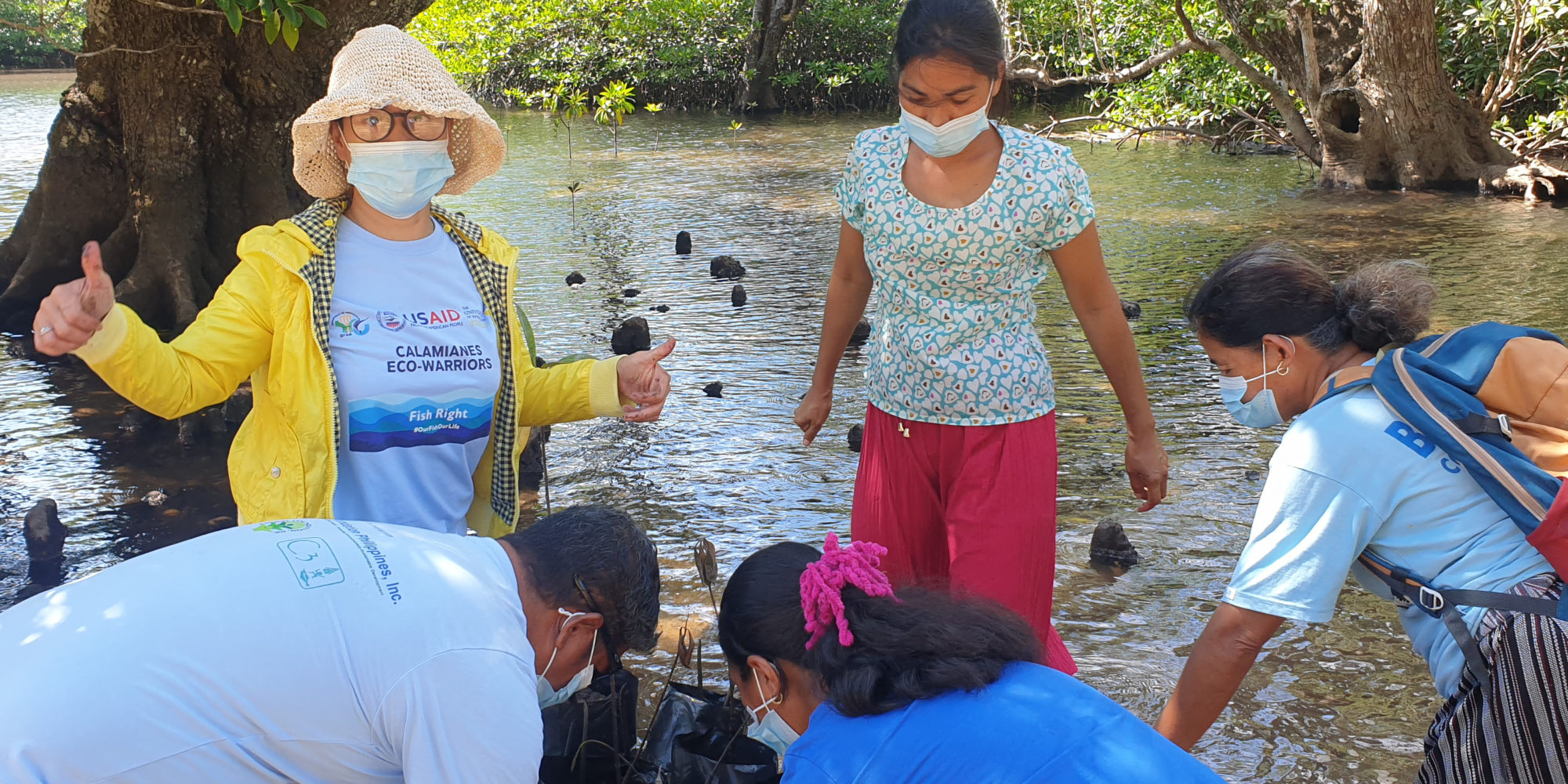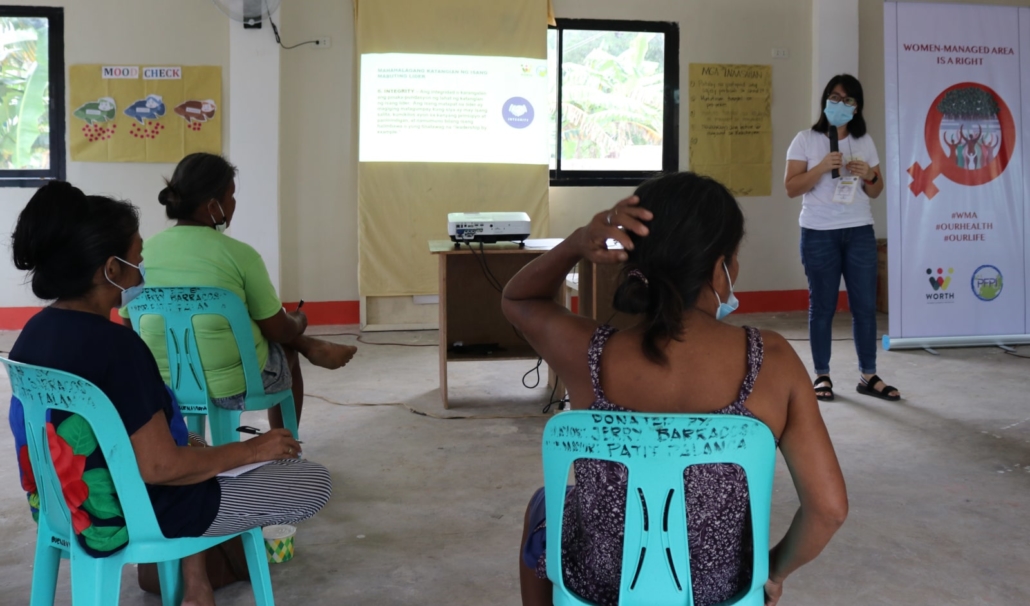
Twin-Bakhaw: Connecting SRH to a Community’s Ecosystem — Part 1
Indigenous women protect their sexual and reproductive health and their marine environment
October 6, 2021
By: Grace Gayoso-PasionVivien FacunlaLiza GobrinNemelito Meron
This post was originally published on the Knowledge SUCCESS website. To view the original post, click here.
The Twin-Bakhaw project advocates for gender equity via sexual and reproductive health services among indigenous populations. Each newborn will have a “twin” mangrove seedling, which the newborn’s family must plant and nurture until it is fully grown. The project exemplifies the importance of family planning and reproductive health interventions in long-term environmental protection measures. This is part 1 of 2.
Connecting a Community’s Ecosystem to Family Planning and Reproductive Health
The Twin-Bakhaw (short for bakawan, which means “mangroves”) project provides a unique approach to advocating for gender equality and sexual and reproductive health services in fisheries management, within indigenous populations. This 10-month project operates under a scheme that each newborn in the family will have a “twin” mangrove seedling, which the newborn’s family must plant and nurture until it is fully grown, thus the name Twin-Bakhaw. The project’s success shows how important integrating family planning and reproductive health (FP/RH) interventions are for long-term environmental protection, food security, and disaster mitigation. PATH Foundation Philippines, Inc., leads the project, which is implemented in two barangays (villages) in the two municipalities of the Calamianes Island Group (CIG)—Barangay Buenavista in the municipality of Coron and Barangay Barangonan in the municipality of Linapacan. The CIG, one of the most bio-diverse groups of islands in the Philippines, is home to the Tagbanuas, one of the oldest indigenous populations in the country.
Various studies have long shown the correlation between growing population and depletion of natural resources (attributed to overfishing, illegal, unregulated, and unreported fishing practices) may eventually lead to food insecurity—a social problem that the world is continuously working on, given the commitment of governments to zero hunger by 2030 as part of the Sustainable Development Goals (SDGs).
Women, particularly those in poor and vulnerable communities such as indigenous populations, face the burden of food insecurity. Dependent on natural resources for food and livelihood and given the responsibility for their family’s health and nutrition, women are key contributing factors to both sound environmental management and the community’s health status.
The Philippines has long responded to this complex relationship between community health and the environment through its use of a multi-sectoral population, health, and environment (PHE) approach. This Twin-Bakhaw project, with its unique approach to enhancing indigenous women and female youths’ roles in fisheries management and promoting gender equality and sexual and reproductive health and reproductive rights (SRH), adds to the Philippines’ decades of experience in PHE programs. (For more information on the rich history of PHE in the Philippines and PHE implementation guidance and lessons learned, check out this recently released publication entitled History of Population, Health and Environment Approaches in the Philippines.)
Grace Gayoso (Gayo) Pasion, a Knowledge SUCCESS Knowledge Management Regional Officer based in the Philippines, recently spoke with Twin-Bakhaw project team members—Field Program Coordinator Vivien Facunla and the Assistant Field Project Officers Ana Liza Gobrin and Nemelito Meron—to learn more about how they integrated SRHR, gender, capacity building, and environmental protection through the Twin-Bakhaw project.
Every time a woman gives birth, a mangrove tree will be planted and named after the newborn. This shows the unity of family and a way of protecting the mangrove.
Part 1
Gayo: Can you tell us a little bit about the Twin-Bakhaw project? Why was it called Twin-Bakhaw?
Vivien: The idea started when I attended the lab program under the WORTH Initiative, facilitated by an organization called ARROW based in Malaysia, wherein we were taught about SRHR. At the end of the program, we were assigned to think about the type of project that we can do in our own project sites that incorporates the three themes—environmental conservation, climate change, and SRHR. Our USAID-funded Fish Right program started a women-managed areas (WMA) activity for women to manage their marine resources, but it didn’t have an SRHR component. It was focused more on sustainable fishing. This Twin-Bakhaw project is an added value to the Fish Right program. We target the indigenous women since they are usually the ones who have no opportunity to manage resources, to decide, to participate, or to exercise their rights.
Ana Liza: It was called Twin-Bakhaw because every time a woman gives birth, a mangrove tree will be planted and named after the newborn. The number of mangroves planted will equal the number of babies born in the community. This is a symbol of stewardship and a way to monitor the number of children in the village…[the project] is really focused on how sexual and reproductive health is linked to the environment and climate change.
Watch WORTH Vlog Video #1, which introduces the project overview.
Gayo: What inspired the project to focus on indigenous women?
Vivien: I saw that the women in these areas do not have a big role in fisheries management. Usually, they will attend meetings not to represent themselves but as an alternate for their husbands. When they make decisions, they will always say, “I’ll first ask my husband if it is okay.” You cannot see them empowered when it comes to management. So the concept of women-managed areas allows women to do the management of coastal resources themselves.
Ana Liza: Women-managed areas are proof that women can lead—that they can decide for themselves and that they have a voice.
Nemelito: This project presents an opportunity for women to participate, lead, and influence the decision-making process in managing the designated protected area and to have access to marine resources.
Gayo: Why is the focus on protecting the bakawan or mangroves? What roles do mangroves play in the communities in which you work? What is their importance?
Nemelito: Mangroves are very important habitats for breeding fish and other marine species. It is a defense for coastal communities against the effects of climate change, such as storm surges and flooding, and is also carbon storage. It is one of three key parts of marine biodiversity, which includes coral reefs and seagrass. It plays an important role in the livelihood of most women fishers in the community. The area is where they glean shellfish for food and profit. (Note: Gender in Aquaculture and Fisheries defines gleaning as a “fishing method used in shallow, coastal, estuarine, and freshwaters or in habitats exposed during low tide…other terms used for this type of fishing are ‘gathering’ and ‘collecting.’”)
Vivien: Women in these areas are most comfortable in the mangrove areas since, according to them, not all women know how to swim…they are not comfortable in deep areas like the coral reefs. From that information, we conceptualized the idea of designating that [mangrove area] portion as the protected area that they can manage as a start since they are already comfortable in those areas. When they experienced Yolanda in the Calamianes, the villagers saw that houses near the mangrove forest were not destroyed, while houses within the denuded mangrove forest were wrecked. (Note: Super typhoon Yolanda, internationally known as typhoon Haiyan, is one of the most powerful tropical cyclones ever recorded.) This concept of protecting the mangroves was easy for the indigenous community to accept since they experienced on their own the benefits of having mangroves during the typhoon.
“Women have big roles in the fisheries sector, but it is invisible work.”
Gayo: The project integrates SRH, gender, capacity building, and the environment. How do all these components fit together?
Vivien: The Fish Right project conducted an analysis of gender roles in the Calamianes Island Group fishing communities, and it showed that women are engaged in all the stages of the fisheries value chain—from pre-fishing to harvesting to post-harvesting. They prepare food for the husbands before fishing, and they glean and do near-shore fishing. When their husbands return, they also clean and sell the fish, which is part of post-harvesting. Women have big roles in the fisheries sector, but it is invisible work. So the concept of women-managed areas is allowing women to manage the mangroves on their own. Then when the Twin-Bakhaw project came, we thought why not integrate the importance of SRHR for women in the women-managed areas.
Nemelito: The role of women in protecting and managing their SRHR and their environment is very vital in the community. If the woman is healthy, she can better take care of the environment.
For more information about the results of the analysis of gender roles, check out this executive summary of the Analysis of Gender Roles in the Calamianes Island Groups Fishing Communities.
The Twin-Bakhaw Project built the capacity of Tagbanua women on gender sensitivity, leadership, sexual and reproductive health rights, ecosystems approach to fisheries management, and mangrove reforestation.
Watch WORTH Vlog Video #2, which discusses Twin-Bakhaw’s capacity-building training.
Gayo: How do you communicate the relationship between SRH and the environment to the communities you work with?
Nemelito: Conducting training and seminars on SRHR, environmental conservation, and preservation is one way, but being able to relay the important message that if a woman is healthy, she can take care of herself and her family and the environment. If the environment is healthy, they will benefit from it. The healthier the marine ecosystem where they get their food and their livelihood, their food source will be sustained. This logic was really instilled in them…If these women have a lot of mouths to feed because they don’t practice family planning, then eventually, in the future, there will be fewer marine resources for them to rely on due to overpopulation.
Ana Liza: About the link between SRH and their environment, [we say] that if you take care of your coastal resources, which are the source of your livelihood, you will receive positive returns. Of course, you will be able to take care of your coastal resources if you have fewer children, you plan your family, and you properly space your children’s births. How will you feed your children if the resources are already depleting? The resources are already dwindling now. If each family within a community has many children, the resources will not be enough. If they have this perspective and if their capacities are built through training and seminars, they will be able to take care of themselves, their reproductive health, and together with their husbands, they will understand the importance of the environment and…women’s role in the community.
Watch WORTH vlog video # 3 from 02:00 to 03:00, which discussed the increase of women’s knowledge on FP and the links between being a healthy woman and having a healthy environment.
Read more about the Twin-Bakhaw project’s challenges, implementation, and replication tips in part 2 of the interview.




